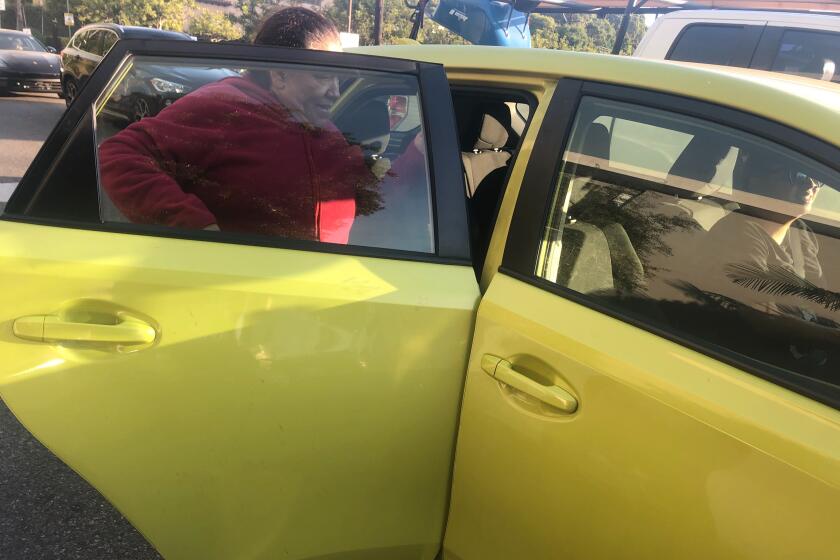She feeds Bel-Air’s mega-mansion boom. But lunch is a battlefield
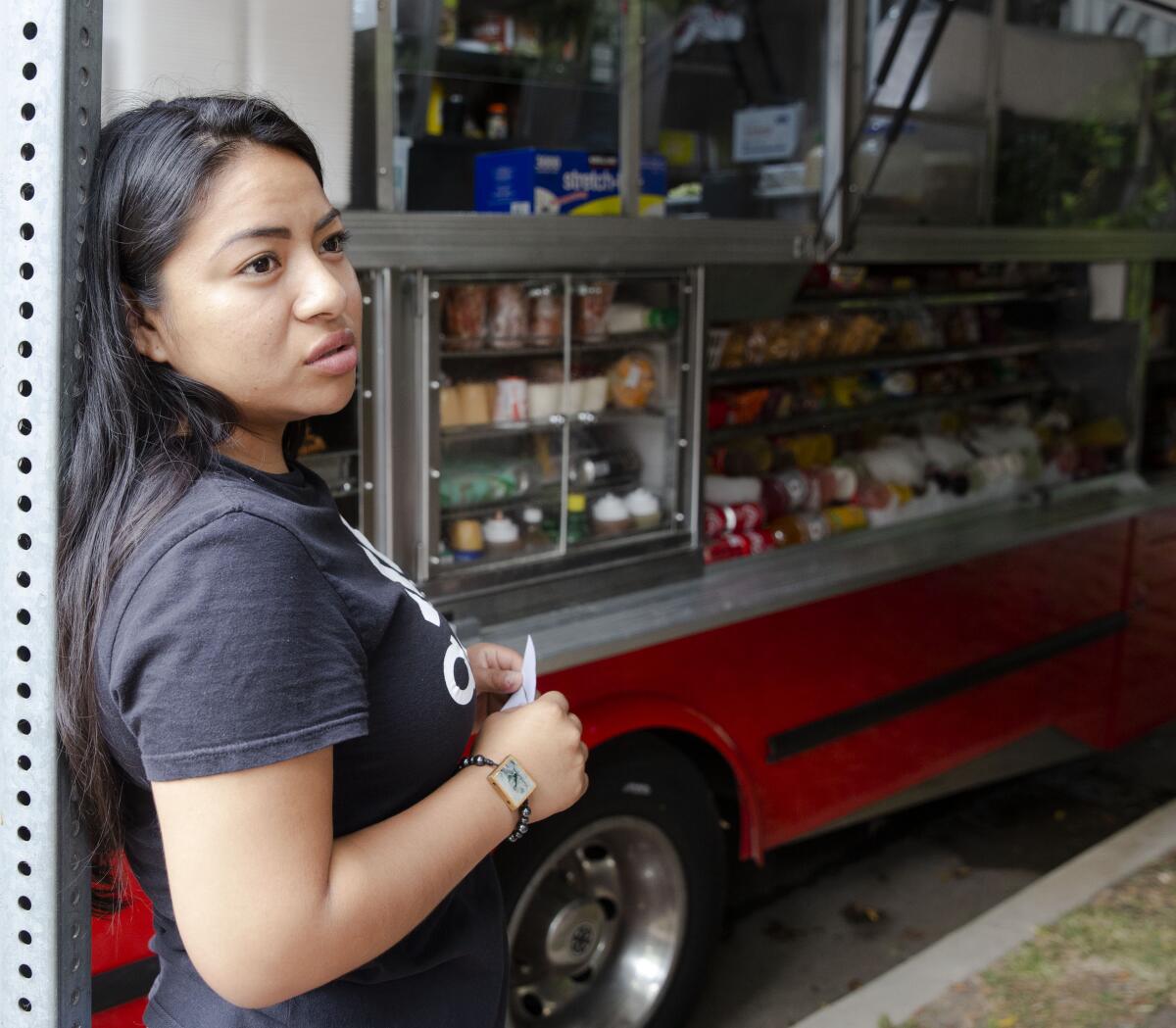
- Share via
Twenty-thousand-dollar date palms fluttered in the breeze and cranes glinted against the sapphire sky as Jennifer Ramirez pulled her lunch truck to a stop outside the half-finished mansion on Bel Air Road.
It was her third stop on a balmy Friday, a bustling site packed with construction vehicles and hardhats laboring behind green privacy mesh. One moment, the 20-year-old from South Los Angeles stood alone on the glittering pavement, her 5-foot frame dwarfed by one of the most expensive homes ever built. The next, she was mobbed by a dozen hungry workers scrambling for their 9:45 a.m. lunch.
“It’s cool [lunch trucks] come up here, because the streets are narrow and tight,” said Joseph Trujillo, 26, who was installing aquarium-style acrylic windows in the bottom of the pool — his third such project in recent weeks — so future partygoers could watch beautiful people swim above them. “It’s nice they come to us.”
On Bel Air Road, grown men run out to meet Ramirez like kids chasing an ice cream truck. They call her “La Chaparrita,” an affectionate diminutive for “shorty,” the nickname of the infamous Mexican drug kingpin Joaquin “El Chapo” Guzman.
Her horn signals a 20-minute break in a 10-hour work day, a chance to trade gossip with gardeners at the compound next door or the carpenters at the site down the block. Los Angeles is in the midst of a development boom, one that operates here at imperial scale. La Chaparrita’s Munch Truck makes 15 stops in four hours, selling hundreds of meals to men who build homes the size of strip malls.
“They’re building all these mansions, and they’re always remodeling them,” Ramirez said. “They’ve built mansions and completed them and then they tore them apart because they didn’t like the way they turned out.”
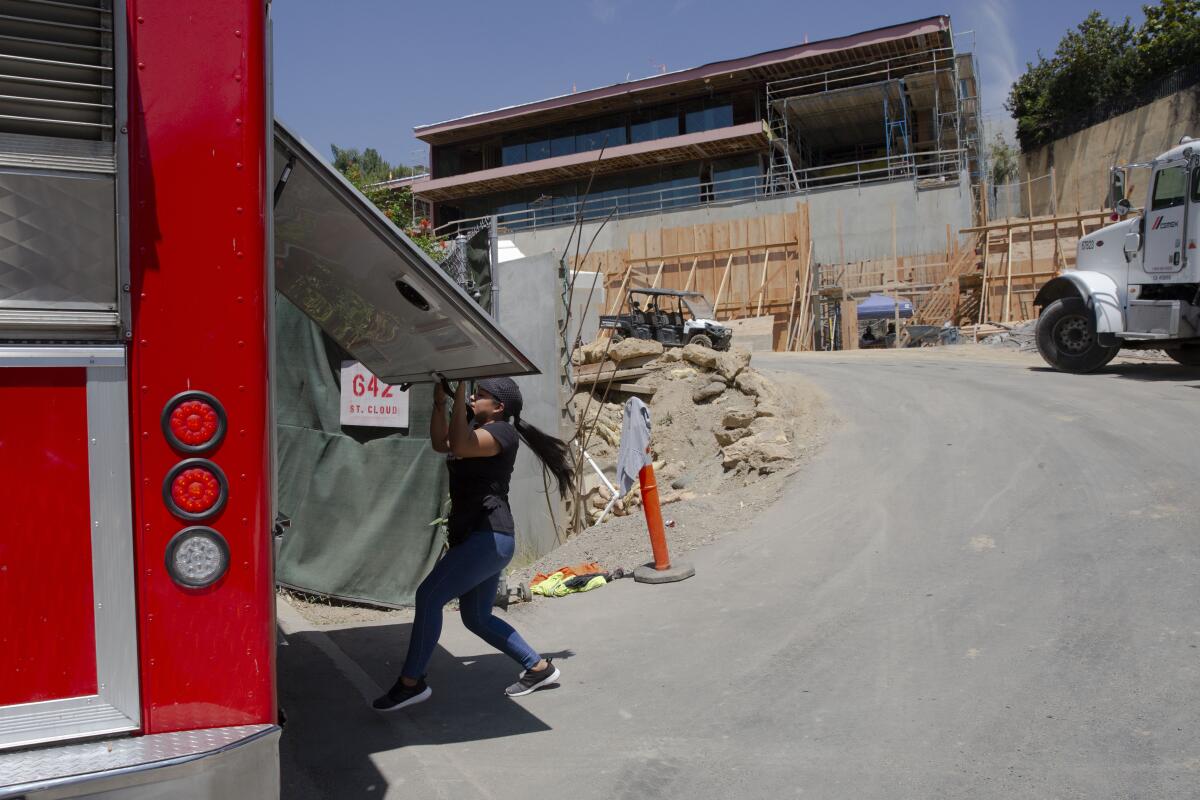
Mohamed Hadid’s unfinished mansion is among those Ramirez serves. Better known to most as the father of supermodels Bella and Gigi Hadid, the billionaire attained local infamy for his 30,000-square-foot Strada Vecchia citadel, an icon of palatial excess in a neighborhood increasingly antagonistic to new construction, and to those who attend to it.
“I’ve got a community on the edge of revolt,” said Shawn Bayliss, executive director of the Bel-Air Assn. “Imagine building a Target. Now imagine putting that on a 22-foot-wide street that dead-ends, and imagine putting three of those on the same street. We’re overwhelmed.”
: :
The so-called Platinum Triangle of Bel-Air, Holmby Hills and Beverly Hills is dotted with enormous new mansions, many of them built on speculation by developers banking on mammoth returns. But those going up in Bel-Air are of another order, experts say.
“They range from a low of 10,000–20,000 square feet in the Bird Streets [an enclave above the Sunset Strip] and Trousdale [a neighborhood in Beverly Hills] to 40,000–50,000 when you get into Bel-Air,” said Stephen Shapiro, chairman and co-founder of Westside Estate Agency. “Some of the really big ones have aesthetician rooms for manicures and Botox. There’s one house I saw not long ago that had nine bars in it.”
Such modern fortresses of concrete and glass command armies of workers to build them, and a squadron of caterers like Ramirez to keep them fed. On any given weekday, 12 to 15 food trucks patrol the streets of Bel-Air alone, serving hundreds of men who may labor on the same site for months, even years.
As the Getty fire rages, the streets were mostly empty in the nearby neighborhood — except for the workers who tend the gardens, clean the hilltop homes and care for the children in one of the city’s most affluent communities.
“The super-rich keep dozens and dozens of households afloat on every job site,” said Aaron Mead, a 25-year-old fireplace specialist who works regularly in the neighborhood.
To those who gild these streets with their sweat, the boom has been a blessing. But for those who live here, new development is a nightmare.
“You’ve got a developer who doesn’t even live in the community building a house with people who also don’t live in the community, and no one cares,” Bayliss said. “We are awash in construction. Add the filming, add the lunch trucks, add the tour buses — and if it’s Wednesday it’s also trash day, so there is a competition of huge vehicles on the smallest of hillside streets.”
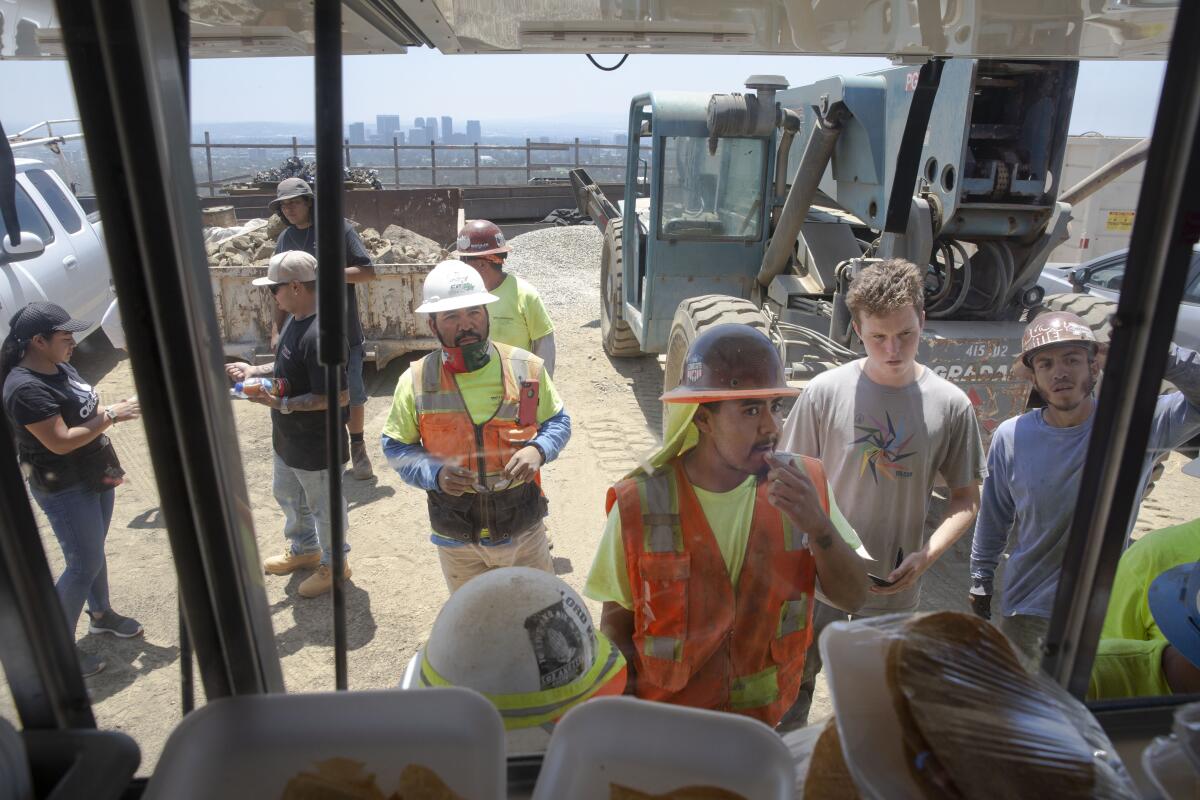
Anger crackles in the air, looking for somewhere to ground. The developers are absent; the tourists, ephemeral. Workers spend their days veiled by mesh construction screens, and the film crews are shielded by location permits. Alone with no imprimatur, the lunch truck is a lightning rod.
“Thank you, nos vamos, bye!” Ramirez called out some 10 minutes later, her black ponytail bouncing as she leaped to pull the service windows down.
She hopped into the driver’s seat and started the engine, waiting for a cement mixer to pass before inching out onto the narrow strip of Bel Air Road. But before she could merge, another driver swerved ahead of her, arching out of his seat to scream invective from the window of his black Rolls-Royce.
“He’s like, ‘I’m the owner, I’m in charge, and I don’t want you here,’” Ramirez said, still visibly shaken when she reached her next stop. Two months before, the same man had taken two bottles of water from her and refused to pay. “He said, ‘I’m the owner of the house,’ so I gave them to him for free.”
For those who labor in the shadow of fortune, this is what a living costs.
:

Mornings start before sunrise at the sprawling Slauson commissary in South Los Angeles. Some 300 food trucks rent space here, drawing hundreds of women and a handful of men to clean, prep and cook ahead of the day’s service. By 5:30 am, crews were already on their way out, headed to the factories in Vernon to serve the morning shift.
Ramirez’s cooks, Hilda Garcia and Yamileth Hernandez, were well into their prep for the day, cumbia superstar Aniceto Molina’s “El Diario de un Borracho” (“The Diary of a Drunk”) crooning from the speakers as the smell of grilled meat filled the air.
La Chaparrita’s most popular product is carne asada — the truck sells about 20 pounds a day — but carnitas is a close second. Other favorites include pupusas and breakfast burritos. On Fridays, the team serves shrimp cocktails and whole fish.
Ramirez arrived around 6:30, her waist-length hair wet and loose down her back. She is studying for her associate’s degree in small business entrepreneurship, and homework had kept her up until midnight. At 6 a.m., her alarm rang for work.
“In my classes, one of the assignments was to think of a small business and how you would work hard to pursue it,” she said with a nod to her scarlet truck. “I don’t know how to cook much, but I’ve grown up next to my mother.”
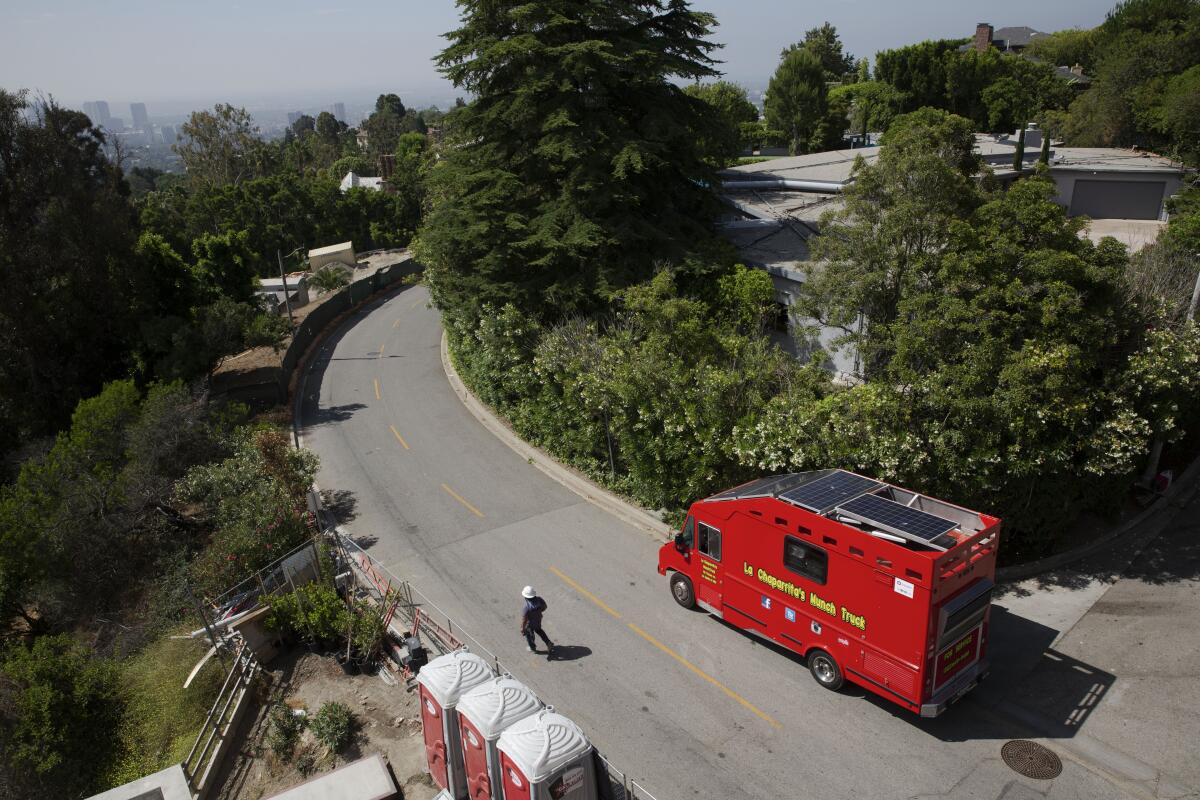
Ramirez was born in South L.A. and raised on this lot, watching her mother work her way from a lunch truck cook who sold hot dogs from a cart on the weekends up to the owner of her own Workhorse truck, and later to the boss of a small fleet of subcontractors across Brentwood and the Platinum Triangle.
“Yesterday we came across a woman selling food from her car — I know there was a child with her, and I know my mother was in that same place,” Ramirez said. “As I grew up I saw her struggles. She’s an idol for me.”
Her mother’s hard work helped change their fortunes, but struggle was never far away. Competition is fierce in the food truck business, and with significant operating expenses, a rainy day can put owners in the red. In 2016, Ramirez dropped out of Venice High School to help her mother keep the business afloat and support her three younger siblings.
“I started renting a food truck from my mom when business was bad,” Ramirez said. “If that truck doesn’t go out, it doesn’t bring any income.”
By the time the teenager went back to graduate, she’d built a lucrative route on Bel Air Road.
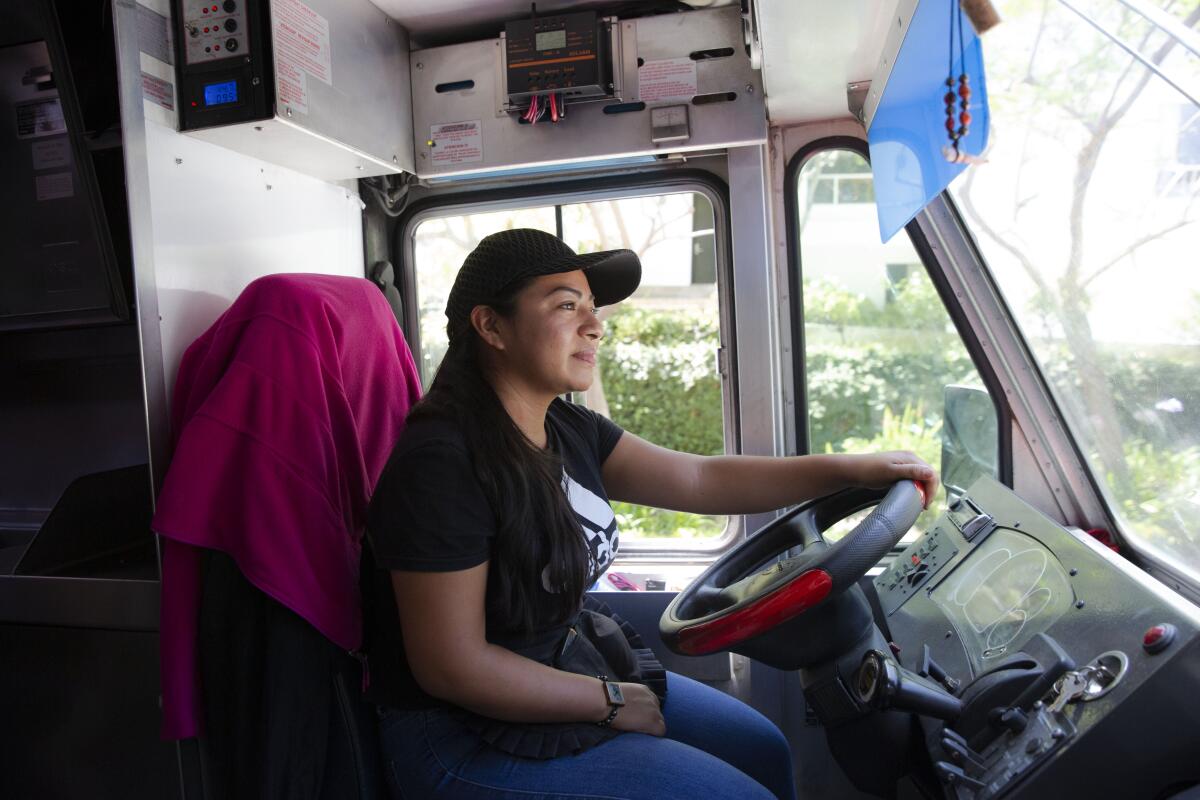
“When I was in school, I didn’t know what I wanted to do,” she said. “I found myself through this.”
At the commissary, Ramirez quickly relaxed into the role of a boss. She grabbed a cup of Special K and a pint of whole milk, eating while she checked her inventory.
‘You don’t know what you’re capable of until you actually do it.’
— Jennifer Ramirez
Though she buys most of her supplies from a warehouse, last-minute items come from an on-site bodega, its aisles lined with display cases of pastries, flats of Mexican Coke and 7-pound cans of Hunt’s tomato ketchup.
“You should try to rest,” she told the cashier, who counted small bills from behind a security cage lined with chef’s knives for sale. “I know work is important, but you should also take care of yourself.”
It was advice the young entrepreneur could scarcely afford to heed. When she returned to work full time, Ramirez had planned to keep renting from her mother. But the matriarch had other ideas. With $40,000 left on the lease, she offered to transfer the permits for the 12-year-old truck to her eldest daughter.
“This is where you can actually show me what you’re capable of doing — can you really run a business on your own?” Ramirez recalled her mother telling her.
Ramirez used her savings to pay $20,000 toward the remainder of the lease, and when she’d worked off the balance she took a loan from the commissary’s owner to have her truck remodeled.
“It ended up so much money, she was concerned I would be in debt paying it off. But I think I’ll be OK,” Ramirez said. “You don’t know what you’re capable of until you actually do it.”
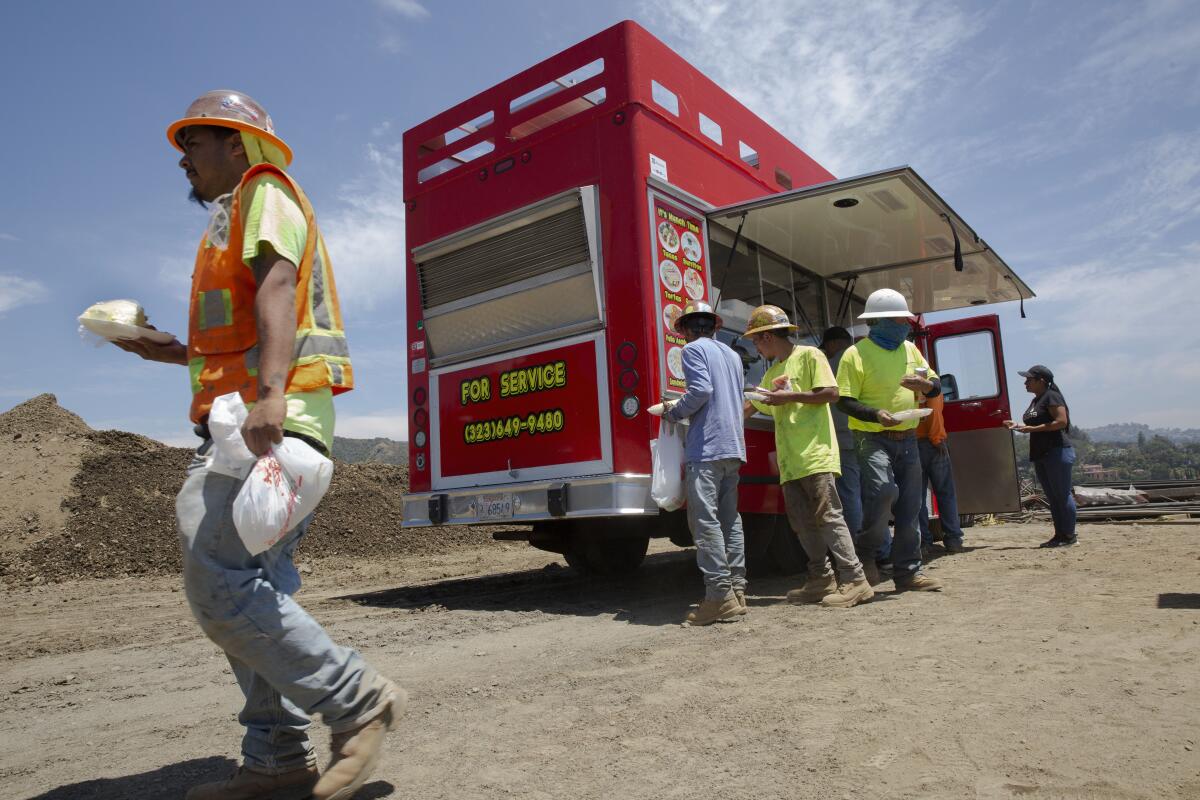
::
“Chaparrita ... Is that you?” a gardener asked, gesturing at the name freshly painted on the side of the truck. Ramirez had just pulled to a stop at the mouth of a driveway on a seemingly deserted stretch of Bel Air Road. But the moment she leaned on her horn, a pack of workers appeared, and soon a line hugged the blind corner.
“Where are you from?” the man asked, grinning eagerly.
The gardener was new, so Ramirez indulged him. Her family is Guatemalan, she explained without smiling. Her cooks are from El Salvador and Mexico.
“How much is the juice, beautiful?” a second man called.
Ramirez told him, her tone polite but matter-of-fact.
“Make the burrito like it’s for your husband,” a regular cooed to Hernandez.
The cook rolled her eyes.
“Any new customer that comes will try to ask me, ‘What’s your name? Where you from? Would you ever want to go out?’” Ramirez explained as they drove away a few minutes later. “The more you pay attention to these men, the more they try to mess with you.”
The lumbering scarlet Workhorse often feels like a refuge, a foxhole of female privacy. Unlike sidewalk vendors, whose activities were decriminalized statewide only last year, lunch trucks have been licensed and regulated for decades, with strict oversight from health officials. The law also protects trucks more aggressively than other mobile food vendors.
But the best routes are still built on handshake deals, and competition abounds. There’s no escape from the grind in Bel-Air, nor the wrath of the neighbors. Wherever she stops, someone tells her to leave. Wherever she looks, Ramirez is confronted by how the other half lives.
“One of the houses up there, I watched them bring in 16 palm trees. Each one is $20,000. But this is where we eat,” Ramirez said. “If it weren’t for these snobby rich people, there wouldn’t be any construction workers. There wouldn’t be any food trucks.”
Gardeners, pool boys, housekeepers — all have benefited from the proliferation of colossal new homes. Expensive abodes are expensive to operate. A developer must pay to have his investment maintained even while it’s sitting empty, awaiting its millionaire buyer.
“In this house, there’s only one person living here and 14 people who work here,” said Roberto Rodriquez, 47, who bought Chaparrita’s Friday fish special. “Cleaning people, service — there’s easily thousands of us.”
::
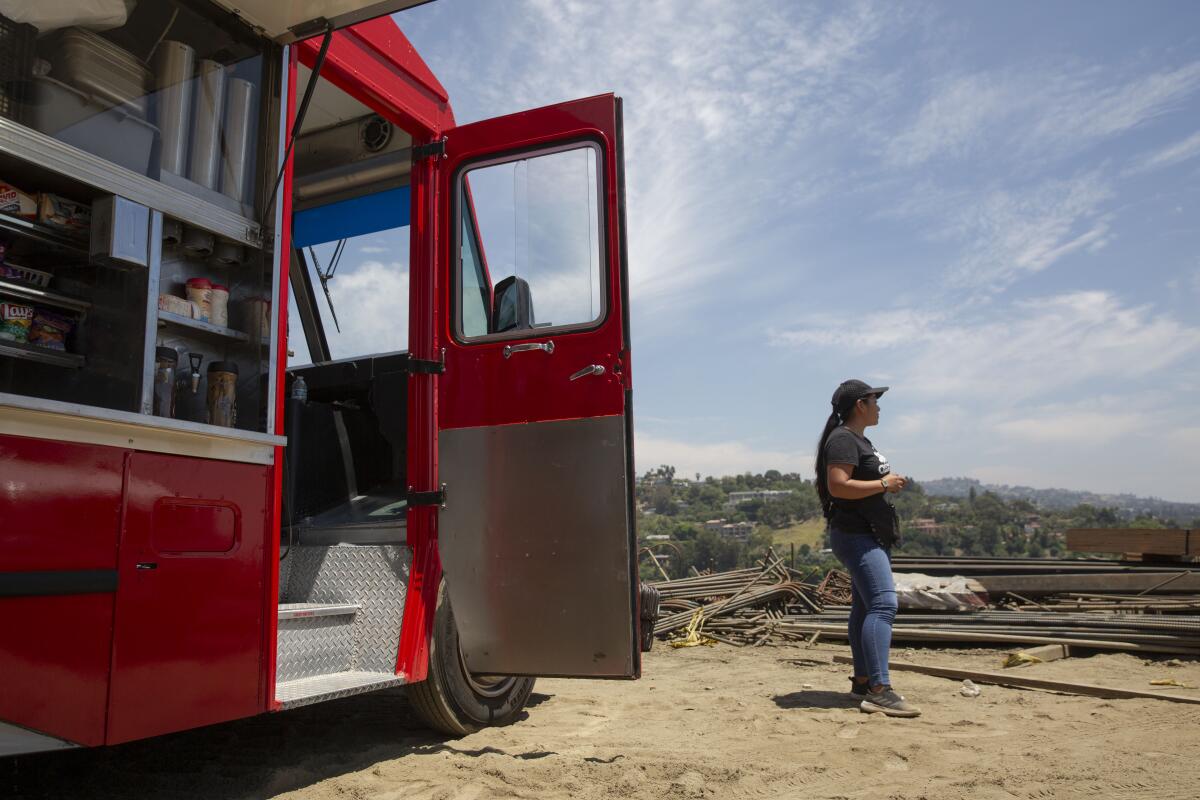
It’s impossible to spend a day here and not comprehend how skilled labor is valued relative to Italian marble or Canary Island date palms. On a good day, Ramirez clears $200 after expenses. On a bad one, she goes home with nothing but the names she’s been called.
“It’s like they’re trying to humiliate me,” she explained, fighting back tears. “It’s just things that happen; it’s things I’m used to. It’s the anger and the sadness that I just have to swallow.”
Like her customers, Ramirez leans on this place to survive.
“These rich people, they feel like they’re over all of us,” she went on, anger creeping into her voice. “When I was talking to that guy [in the Rolls-Royce], all the workers were quiet. They would never say anything, even if the guy would have gotten out, cussed me out, even if he would have slapped me, they wouldn’t have done anything. Because that’s their money. They’re scared of losing their job.”
For her, the food truck offers freedom from that fear. She dreams of a life beyond construction, of catering events and earning a following on Instagram. The man who humiliated her might keep his workers inside on Monday, as others have done when she talked back to them. She might lose that dollar, but money is thick on the ground in Bel-Air.
“That’s one thing my mom has always told me — ‘You were born here; you speak English. You have every right to defend yourself. And I expect you to do it. I expect you to stand up,’” Ramirez said. “I stand up for all of us.”
More to Read
Sign up for Essential California
The most important California stories and recommendations in your inbox every morning.
You may occasionally receive promotional content from the Los Angeles Times.

